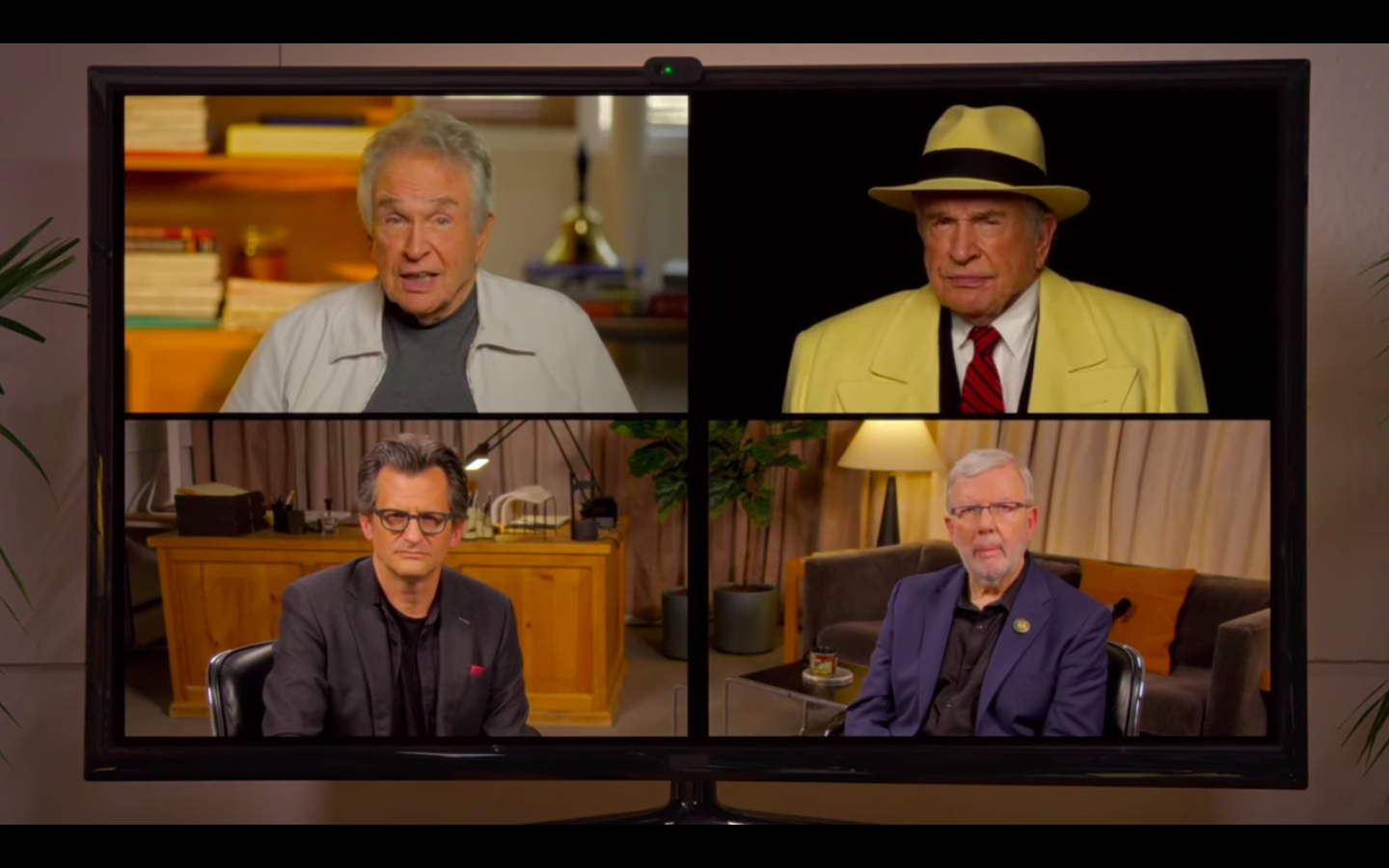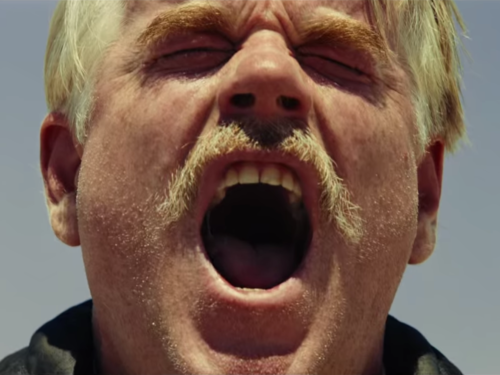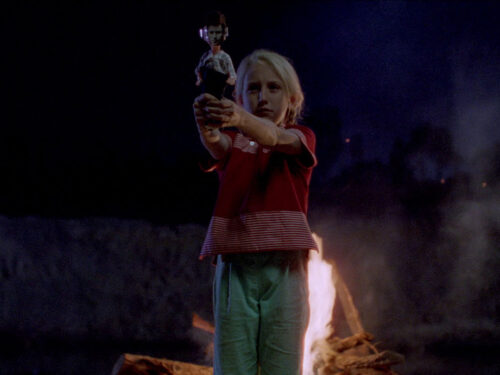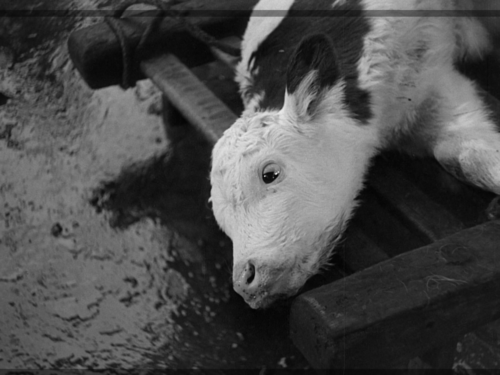Both inevitable in our era of brand extensions and totally unprecedented in the history of cinema, Warren Beatty’s pair of Dick Tracy TCM specials offer an embarrassment of riches for anyone fascinated by their director-star’s peculiar career
What if Clint Eastwood’s infamous chair speech had aired on cable in the dead of night instead of live for millions at the Republican National Convention? What if he’d mimicked his Dirty Harry character throughout and chosen real-life Eastwood as the target for his jabs? What if Pauline Kael had moderated? Finally, what if “Dirty Harry” did it all again more than ten years later with a new interest in both repairing his relationship with “Eastwood” and supporting his previous arguments with video evidence? Imagine that bizarre hypothetical and you have some idea what Warren Beatty’s pair of Dick Tracy specials for Turner Classic Movies1 have in store.
The 2009 Dick Tracy Special is among the strangest exercises in franchise extension ever assembled. Its follow-up, subtitled Tracy Zooms In (2023), is among the most strangely affecting auteur efforts in recent memory. In the first, we hear Dick Tracy, clad in his familiar yellow fedora and trench coat, credit his uncommon longevity to portion control, the occasional blueberry, and, most of all, pomegranates. You see, he’s even older than Beatty; with some goading from his host, Leonard Maltin, Beatty-Tracy reveals he’ll be 107 soon. That makes him 121 to Beatty’s 85 by 2023. Had Beatty not dusted off his Tracy costume back in 2009 for that improvised bit of banter, we’d probably have heard plenty of worse quips from the square-jawed detective by now in a modern reboot. Perhaps Chris Evans would be telling husky criminals like Lips Manlis to “try keto.” Despite growing infamy, the shorts have received very little coverage. On Wikipedia, you’ve got to head to the page for Dick Tracy (1990) and scroll down to the very last section, “Possible sequel and legal issues,” for several paragraphs on Beatty’s battle over the rights and just one for each special. That’s a shame given their potentially unique position in the history of Hollywood copyright cases, auteur vanity projects, and cinema altogether.
Related: That Final Round Up: Clint Eastwood, William McCoy, And Bronco Billy by Bennett Glace
Crass attempts to retain franchise rights are so commonplace that even casual moviegoers can probably name a sequel, prequel, or reimagining that was only produced to keep famous characters in familiar hands. Even still, Beatty’s efforts to retain the rights to Chester Gould’s characters stick out as unusual. They are in keeping with the intense individuality with which Beatty has always gone about planning and executing his utterly singular career. Legally speaking, these cable TV oddities are direct sequels to Dick Tracy, in which the detective himself fields questions on topics including Beatty’s film. Beatty initially secured the rights to the comic strip crime fighter from Tribune Media Services in 1985. When a proper sequel failed to materialize in the years following Beatty’s Disney-produced turn as Tracy, a legal battle ensued. Tribune attempted to reintroduce Tracy on television in 2005; Beatty filed a suit disputing their rights to the character and claiming that years of meddling had stymied his own efforts to produce a follow-up. The actor alleged that Tribune had improperly tried to reclaim the character back in 2002 and a USA Today report on the case found him sounding like the lead in a legal drama: “They picked the wrong guy.” So far, he’s been right. Courts have ruled in his favor on numerous occasions, making it possible to produce Dick Tracy Special, air it, consider it an official sequel, and produce another installment in the franchise. In Tracy’s “first-ever televised interview,” the detective sits across a large desk from Leonard Maltin, who hosts a short documentary on the character’s history while asking a handful of questions. Maltin returns for the 2023 follow-up, though Ben Mankiewicz inherits hosting duties. In an update befitting our atomized, pandemic-era existence and the everyday ubiquity of screens, Tracy opts to give Mankewicz a Zoom call rather than stop by. To Beatty’s immense credit, he uses intermittent connectivity issues to distinguish the special’s visual style while avoiding jokes about the mute button.
To become an actor-director on the level of Warren Beatty requires an amount of self possession that can’t help but bubble over into self regard. To direct just five features over half a century and emerge from semi-retirement at 85 to give one of them the Mystery Science Theater treatment requires a near-equal measure of self-abnegation, or at least a sense of humor about oneself that all that self-love might thwart in a non-celebrity. It’s that paradoxical mix that defines the best efforts from actors who direct. That’s Clint Eastwood finding room for both familiar family strife and plenty of group sex in The Mule (2018); Woody Allen putting one avatar through the degradation of a work-for-hire TV directing gig while letting another get away with murder in Crimes and Misdemeanors (1989); and the choice of actor-auteurs throughout the ages to cast themselves in roles from Jesus Christ to Jackson Maine. Beatty’s is the story of the actor-director taken to its grandiose apotheosis.
Few actors have so quickly and definitively distinguished themselves as both the kings of Hollywood and the authors of their own ascendant careers as Beatty. Though Tinseltown had embraced many handsome stars by 1962, Beatty’s careful behind-the-scenes maneuvering, often hand-picking his collaborators and always exerting control over his material, was rare enough to raise eyebrows. By the end of the decade, Beatty’s perfectionism and argumentative relationship with his directors were as infamous as his relationship history. His great ambition was to steer the ship as producer like a Golden Age studio boss and he got his wish with 1967’s Bonnie and Clyde. In his essential Pictures at a Revolution: Five Movies and the Birth of the New Hollywood (2008), Mark Harris writes that some directors shied away from the long-brewing project for fear of doing battle with Beatty. It was well known that he intended to serve as an especially hands-on producer. Arthur Penn, Beatty’s first choice, ultimately got the job precisely because Beatty knew he could count on the Mickey One (1965) director to butt heads with him. Harris quotes Beatty:
“So when he said he would make this movie, I said, ‘I want to have one agreement – that if we make this movie, we will have an argument every night. If we don’t have anything to argue about, I want to find something to argue about, because there’s always something that can be better or be thought about more.’ That’s what I wanted the dynamic to be.”
Harris’ chapter on Bonnie and Clyde’s production catalogs all the ways Beatty and Penn delivered on their promise to one another. What Beatty still calls a “dialectic2” as of Tracy Zooms In amounted to hours-long arguments over the most minute detail, often stretching late into the night. Even Beatty admits to Harris, “I can be obnoxious.” Despite a troubled production and disdain from some crusty, old guard critics, the film earned acclaim, Academy Awards attention, and, for its leading man, a lifetime ticket to occupy any and every behind-the-scenes role.
Though the term dialectic is perhaps more fitting the material of Beatty’s solo directorial debut, accounts from the set of Reds (1981) suggest the decade-plus since Bonnie and Clyde did little to mellow Beatty’s filmmaking style. A synopsis alone makes plain that Beatty’s sense of personal grandeur had only grown in that time. Actor-auteur and material are rarely more provocatively matched than Beatty was with his look at the short and eventful life of Socialist journalist and Soviet defector John Reed. Following his highly successful co-directorial debut, the romantic comedy Heaven Can Wait (1978), Beatty was undoubtedly interested in correcting the narrative as much as proving his mettle. His second turn in the director’s chair culminated in an epic-length refutation of the notion that he was anything like his debut’s dumb guy protagonist, anything besides an especially intelligent, serious, and politically minded Hollywood star. Three globe-trotting hours complete with interjections from Reed’s real-life contemporaries provide Beatty the opportunity to teach a history lesson while underlining his Left-wing bonafides by embodying a kind of martyr who also gets plenty of time for romance and Beatty’s characteristic befuddled mugging.
Dick Tracy undercuts the seriousness of Reds with a playful subversion of its star-director’s Hollywood Liberal image. Save a physical resemblance, one Tracy acknowledges in Dick Tracy Special, there’s little to connect Beatty with the character first brought to life onscreen by Ralph Byrd and Morgan Conway. Thanks to its art deco aesthetic, torrent of tie-in merchandise, and incredibly familiar Danny Elfman score, the film cannot help but play like a refracted version of the Batman (1989) clone Disney so obviously hoped it would be. Beatty, for his part, seems committed to outdoing Michael Keaton as an unlikely, even eccentric, choice of comicstrip hero. He maintains a straight-faced expression worthy of another Keaton, never echoing the absurdity of his surroundings or the incongruity of the role, a two-fisted, Right-leaning crimefighter. His decision to perform his own stunts (including a less-than-convincing jump onto the roof of a moving car) appears more like a Brecthian distancing effect than evidence of a bottomless ego. In Tracy Zooms In, the detective singles out both of the film’s showcase stunts for criticism, suggesting perhaps that Beatty knew all along how they looked. Without literally smirking the way an on-screen superhero might today, Beatty signaled to his 1990 audience that it was OK to recognize that Tracy jumping out a window to slide down a lamppost and onto a car looks nearly as jarring as Prune Face and Big Boy’s bizarre mugs. There’s a reason only comicstrip and comic book artists dare try to render such things.
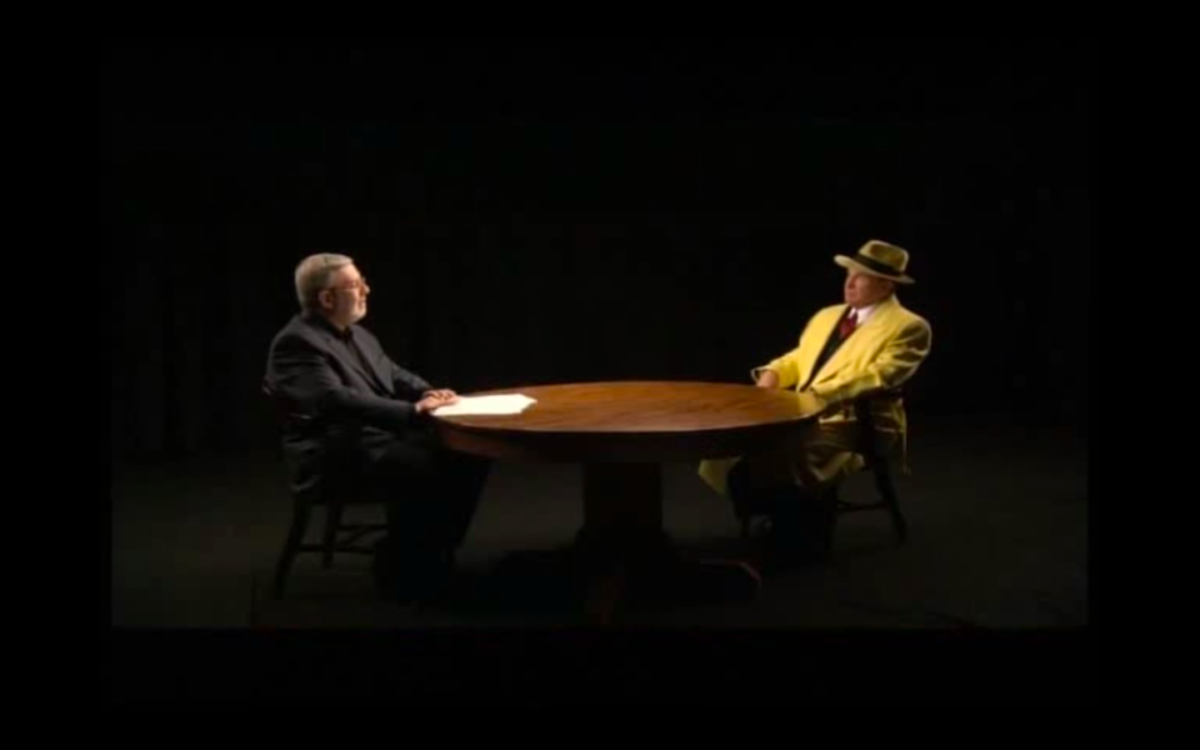
Despite the detective’s insistence that he doesn’t care for Beatty, the lines between Tracy and Beatty become blurred almost immediately in Dick Tracy Special. Tracy’s arrival on the lot at Disney’s Burbank Studios attracts an absurd response; he earns the sort of reactions Beatty might have inspired in the ’60s or ’70s, something no version of the character, not even his previous iteration, could have expected. The welcomes from studio personnel range from the comically obsequious to the improbably horny. Breathless camerawork from Oscar-winning cinematographer Emmanuel Lubezki helps, lending the special an appealingly wacky backlot pace during these early moments and a lightly nostalgic palette. Leonard Maltin greets Tracy with relative composure yet even the Entertainment Tonight mainstay can’t avoid complimenting his subject’s looks more than once before beginning the interview in earnest. One comment in particular prompts the reverie about pomegranates.
Interview is a strong word for what follows. Mostly, Maltin narrates over a clip show, explaining how Tracy came to prominence, first on the funny pages and then in on-screen serials. He intermittently welcomes Tracy to comment and, fittingly, Beatty’s take on Tracy and his escapades prompts the most interesting responses. To dismiss Beatty and co-director Chris Merill’s one-of-a-kind blend of screwball backstage comedy, television interview, educational documentary, and improvised autocritique as simply cringeworthy risks ignoring at least one truly expert bit of cringe comedy. After Maltin reminds him that Beatty was Dick Tracy’s lead, director, producer, and (uncredited) co-writer, Tracy notes some physical similarities while leveling familiar criticism:
“He certainly doesn’t seem to have a low opinion of himself . . . I will say that, physically, the man looks surprisingly like me . . . But how similar we are to one another, that’s a horse of another color. As you know, he’s kind of public about running around being a bit of what I’d call a knee-jerk Liberal. And that’s something I don’t have a tremendous amount of patience for, I’m a Conservative.”
He concludes with a half-hearted attempt to demur, “I’ve never gotten to know the man so I don’t want to seem judgmental.” Uncomfortable silence, and then, “OK?” as Beatty cuts to a shot of Maltin and Tracy across the table from one another. The absurdity and awkwardness of the conversation seems immense enough to fill the expanse between them and the blackness of the studio around them. Maltin, who has perhaps conducted stranger interviews, doesn’t miss a beat, replying, “No, of course not.” Thanks especially to detours like this, our Maltin-hosted trip through Tracy’s on-screen history does far more than pad Dick Tracy Special’s running time. Like all the swooning, the conversation supports a two-pronged argument, that Tracy is an enduring character and that only Beatty is truly fit to embody him. The credits flatten the distinction between the various iterations of the character by sending us out with The Chants 1961 single “Dick Tracy” rather than any of the original music written for Beatty’s film. Tracy as we’ve just seen him becomes eternal.
Between Dick Tracy “sequels,” Beatty released his long-gestating Rules Don’t Apply (2016) to record-setting levels of commercial indifference and bewildered critical notices. The melancholy late-style masterpiece sets its action against another deliberately artificial set of backdrops and finds Beatty playing Howard Hughes, another role that fits imperfectly despite obvious tailoring. The film evolves, with changes both jarring and imperceptible, from an attempt to turn back the clock and examine Hollywood’s heyday into a wistful reflection on the impossibility of repeating the past or staying on top forever. These shifts not only suit Hughes’ retreat from the public eye and into his own memories, but the differences in tone and form between the two TCM specials. Dick Tracy Special opens with the studio in a state of frenzy right out of Rules Don’t Apply’s Hughes-besotted first act. Ben Mankiewicz establishes Tracy Zooms In’s more incredulous tone and experimental form with his introduction to the second special. Seeming to acknowledge the head-scratching its predecessor inspired, Mankiewicz sounds bemused:
“This may surprise you. It surprises me and I was there, but last year I had the pleasure of having a Zoom call with the famous law man. Pleasure might be too strong a word. In any case, Detective Tracy wanted to talk to me to set the record straight regarding an interview he had done years earlier with Leonard Maltin on TCM. In that earlier conversation, Detective Tracy expressed a clear lack of enthusiasm for the most recent big screen take on his adventures.”
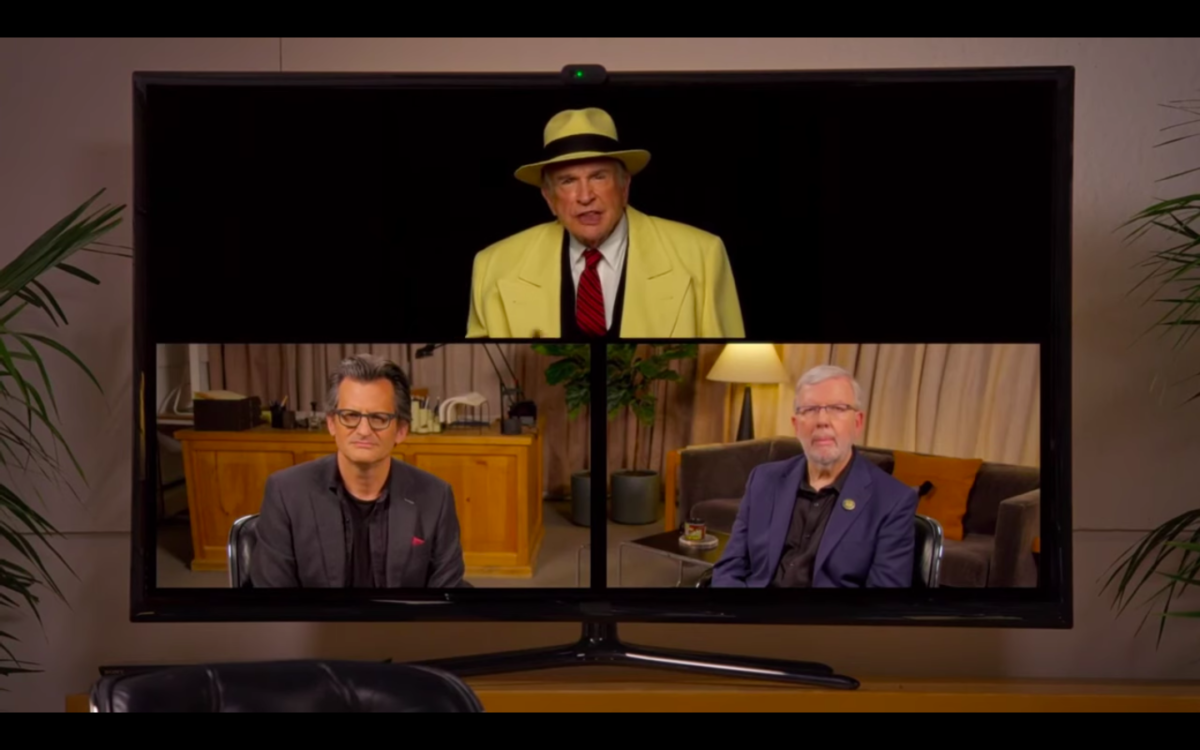
Mankiewicz, whose name evokes Golden Age glory as much as contemporary failures to recapture it, then appears with remote in hand, rewinding the 2009 Tracy special to watch the “pomegranates” exchange over and over again. It baffles him too, perhaps it baffles Beatty in hindsight. It is immediately clear that this second special is about reckoning with the strange reality of the first Dick Tracy Special in addition to Beatty’s 1990 film and legacy as a whole. Maltin reappears to help Mankiewicz make sense of the earlier interview and field the call from Tracy. Walking with the help of a cane, he cuts a more poignant figure this time around and he’s not the only one. More than ten years after Dick Tracy Special and more than 30 years after the original film, Tracy’s tone is much different, though our hosts might insist he hasn’t changed a bit. He is now primarily interested in bolstering his arguments with the help of video clips and repairing his relationship with Beatty while he still can. “I think I could have been better,” he says of his 2009 interview, which is really to say that it could have been better. He starts off with a clip from an interview between Beatty and Mankiewicz “from some time back.” The interview (which I’ve yet to track down and would believe was recorded explicitly for the special) sees Beatty claim, “I’ve always believed in a collaborative process of making a movie . . . we’re all capable of directing really.” Tracy calls to mind countless Beatty collaborators when he voices his incredulity. “[Beatty] never expressed any interest in my opinions,” he says. Beatty has spent more time throughout his career attempting to set the record straight than he has directing or perhaps even acting. By reviving his own creation to call bullshit on all his claims about what it means to collaborate on a film set, Beatty takes self-congratulation and self-flagellation to heights only a rarefied star could reach.
Tracy, not Mankiewicz, most mimics Maltin’s role from the previous film. The clip show is reversed too, with sequences from Tracy’s films preceding the more straight-faced serials starring Tracy’s preferred Byrd and Conway. To illustrate the differences between his sensibility and Beatty’s, the detective offers commentary on Dick Tracy, largely focused on how its surreal look is unsuited to the seriousness of its subject matter. Like its predecessor, Tracy Zooms In counts at least one moment of comic gold among its merits thanks to the dick’s analysis. Staring in disbelief at primary color-heavy frames from Dick Tracy, the man himself quips, “That’s a lot of reds, even for Beatty.”
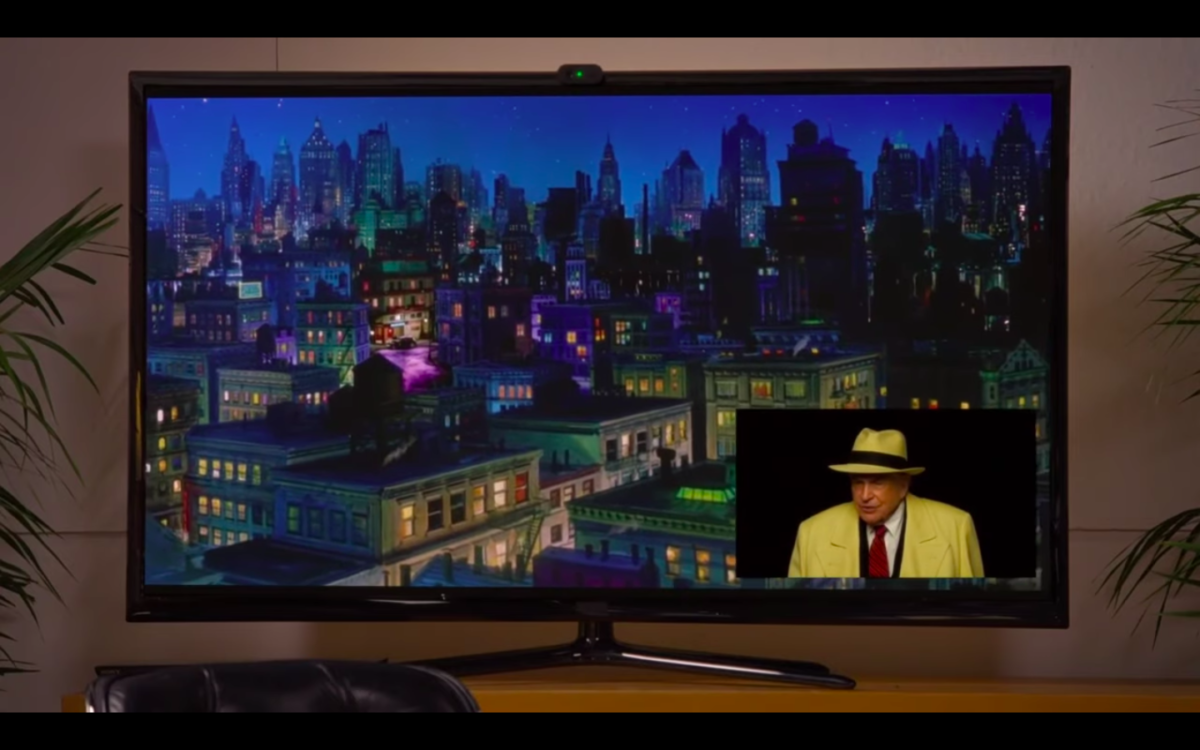
Though we’re meant to find some truth in Tracy’s critiques of Beatty and laugh along, his opinions on Beatty’s work immediately call his taste into question. Tracy’s take on the rightful future of his on-screen persona comes across as especially misguided. It is in keeping with his insistence that the serious business of crime fighting earn appropriately serious on-screen treatment. Once Maltin convinces the real Beatty to Zoom in, he joins the conversation and comes face to face with a funhouse mirror image of himself. Presented with the genuine article, Tracy sounds less like Beatty’s conscience than another franchise-peddling executive. Though even he remarks on the star’s good looks, he has little patience for his directorial style. Tracy’s suggestions for his on-screen future conjure images of the ephemeral brand-sustaining content that might have been if just about anyone else secured the Tracy rights back in 1985; he shakes us out of an impossible Hollywood dream space and into an all-too-real nightmare realm complete with multiverse crossovers and Dick Tracy Jr. on Netflix. “People want to watch movies at home,” he says, like this ought to mean anything, let alone move the likes of Beatty. Tracy continues, “would you think about maybe getting somebody younger to play me . . . and you know, maybe it’s better as a series?” Tracy’s ideas are categorically terrible and scarily familiar. Beatty trusts us not to take them too seriously. He seems to ask, wasn’t my beautifully tongue-in-cheek, stand-alone take on comicstrip characters better than the serial pablum of today which ironizes its medium while asking for the deference fitting whatever the hell a modern myth is? If Tracy, looking much different, ever does actually get his way and return via streaming series, we’ll likely long for something like Tracy Zooms In. Whether or not Beatty shares co-directing credit with Merrill on both specials, only one man could have made them possible.
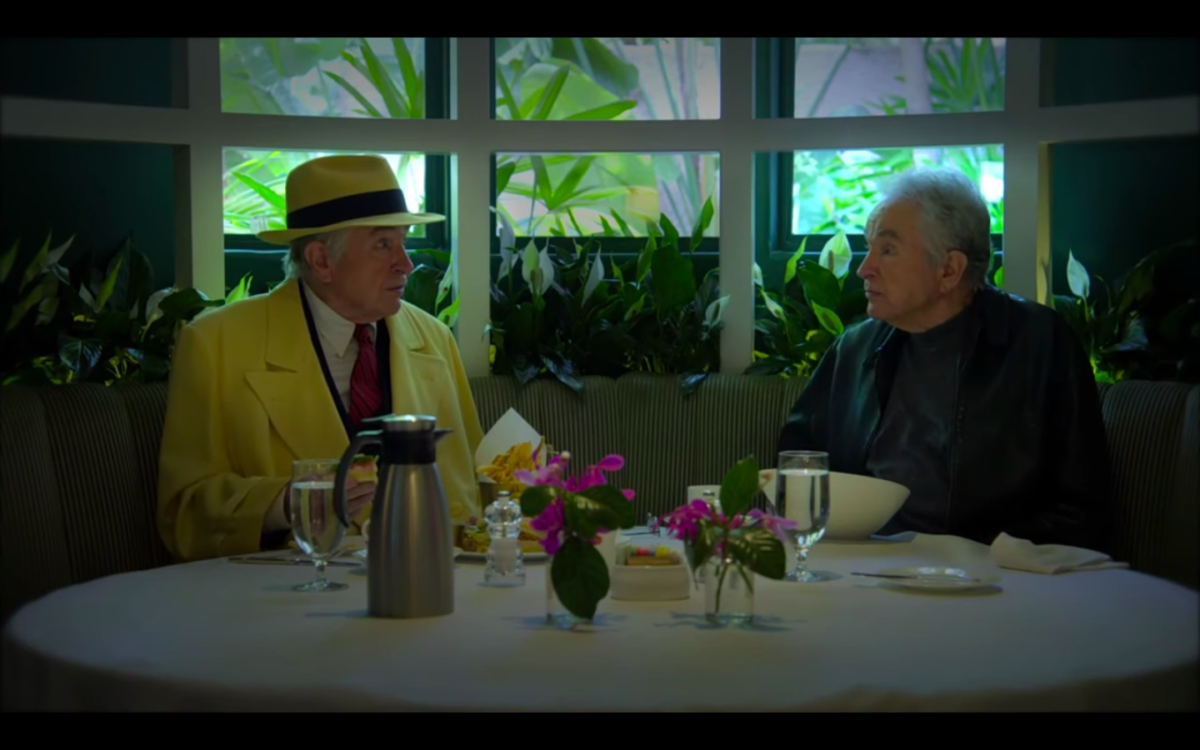
Tracy echoes Carly Simon and innumerable rumors when he charges Beatty with breaking a date at the Polo Lounge where the two were meant to discuss a potential sequel. Beatty apologizes and reschedules. As a result, Tracy Zooms In ends with a rare snippet of Beatty’s famed dialectic collaboration style. It goes about as well as all the stories have led us to expect it would. Our brief look onto their lunch is silent, but appears to end on a sour note. Following an abrupt exchange, Tracy takes a dismissive bite of his food before looking down and away from Beatty. Beatty stares off camera with an expression that’s somehow embittered and wistful. Maybe he really wishes he had revisited the character on the big screen while he had had the chance. He gazes off into a future where little is certain besides his rights to the Dick Tracy name and “universe” for now. Stephen (or is it Sidney?) Sondheim’s “Back in Business” plays and it sounds like a sly joke at both Beatty and Tracy’s expense. The very last Dick Tracy material we’ll see for some time is underscored with music the detective has said he can’t stand, music that pokes subtle fun at its director’s combative brand of perfectionism. Beatty is back in business and it’s business as usual; unfortunately, he is so bereft of worthy combatants that he needs to cast himself.
Stay up to date with all things Split Tooth Media and follow Bennett on Letterboxd
(Split Tooth may earn a commission from purchases made through affiliate links on our site.)
- I first learned about Dick Tracy Special back in 2017 from Justin Decloux and Will Sloan, the co-hosts of The Important Cinema Club Podcast. It has remained a topic of fascination among fans of the show and it even came up when the hosts interviewed Leonard Maltin in 2021. I have, as of this writing, avoided listening to their Patreon coverage of the second Tracy special for fear of pilfering even more insight.
- Beatty’s Bonnie and Clyde co-star, Estelle Parsons on the “discussions” between he and Penn: “I would call it fighting. Every morning we would go to work, and Warren and Arthur would fight for half an hour or an hour. We would be all ready to go and they would start serious, professional, artistic fighting.”

